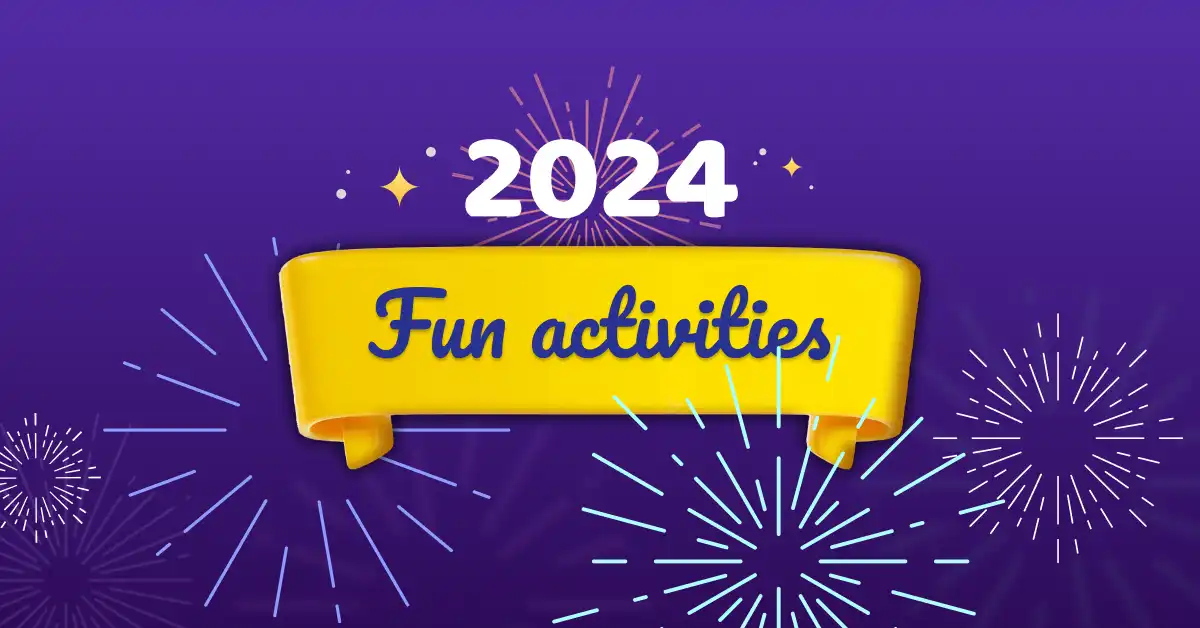With more people working remotely than ever before, virtual training is a fact of life for many businesses. A significant number of Fortune 500 companies use eLearning, with virtual training sessions at the heart of employee engagement and education.
However, it can be hard to make those virtual training sessions really shine. If you’re struggling to keep participants focused or find it hard to get remote attendees talking, it’s time to mix things up with training activities.
What is Virtual Training?
Virtual training takes learning out of the classroom or workplace. A virtual environment affords trainers far more flexibility, making it easy to connect with remote teams and far-flung departments. It can help create a sense of synergy within a larger organization. What’s more, it’s a more cost-effective approach for businesses worried about the bottom line. See this online product sales training template as an example.
Online training can be used to introduce company-wide best practices to an entire workforce or form part of the onboarding process for new employees. You can use your go-to coach as a virtual trainer, while many of the same training resources can be repurposed for virtual employee training sessions.
While the virtual classroom has many benefits, some organizations struggle to integrate virtual training into their operation. It presents specific challenges not encountered with face-to-face learning, requiring a slightly different approach. It can be hard to keep a virtual team engaged, while online tools need to be used to support online collaborative learning.
Virtual training activities can help liven things up, encouraging attendees to work together and fully embrace the benefits of a digital platform.
Why Do We Need Virtual Training Activities?
Unless you’re happy to settle with a trainer reeling off huge volumes of information to an online audience, you need to think seriously about virtual training activities. Some activities can be used as an icebreaker to get people talking. Others are more functional, allowing remote colleagues to debate topics, share new ideas, and develop their skill sets.
If you’ve struggled to adopt online employee training in the past, you’re probably falling short when it comes to interactivity. If attendees don’t have the option to engage in a session, they’re less likely to walk away feeling like they’ve learned something.
Some activities are more hands-on, letting trainees put what they’ve learned into practice.
Others can help with team building, creating a sense of camaraderie. If your business uses a lot of remote workers or scattered teams, virtual activities can enrich training programs and fill the gap left by the traditional office environment.
What Do I Need for My Virtual Training?
You can use many of the same training materials online as you would in the real world. However, they may require a little finessing to make them more palatable for an online audience.
You’ll also need a platform that supports interactive training sessions.
Think about integration with learning management systems, how you can incorporate PowerPoint and Google Slide presentations. Gamified learning can engage a disinterested audience, while validated learning models can be used as a more specialized training activity.
Live streaming training video only lets you deliver the bare minimum. Instead, you need something that lets you add interactive elements like online whiteboards, polls, and virtual breakout sessions.
To ensure your training sessions go without a hitch, you’ll also need to prepare an agenda. Provide attendees with a summary outline of what to expect, penciling in plenty of time for breaks. You can also add links to any external resources they’ll need to support virtual learning and spice up your remote presentations.
Here Our Top 9 Virtual Training Activities
Searching for some inspiration to spice up those virtual training courses? We’ve picked out some of the best ways you can bring a little variety to online sessions and make it easier for attendees to connect with training content.
1. Icebreakers
First time hosting a virtual training session? Perhaps you’re onboarding new talent. If there are a lot of unfamiliar faces, a virtual icebreaker is a good way of easing everyone into things. Your aim here is to make everyone feel comfortable enough to actively participate in the session. While shrinking violets are easy enough to stir up in person, it’s typically harder to do online.
Simply asking how everyone is feeling is a great way of getting things off the launch pad. If you’re usually met with muted responses, consider other ways you can get participants to respond. Ask them to reply in emoji form or use a rating poll to mix things up.
Word clouds are another idea. Ask participants to sum up their general mood or how they’re feeling about the upcoming session in one word. You can use the results as a barometer to read the room. Hosting an event where participants will be joining in from all over the world?
Once again, word clouds can be a handy tool.
When in doubt, turn to nostalgia. Ask attendees what their favorite childhood movie was or which candy bar is their guilty pleasure. Shared results will establish common ground and potentially lead to some friendly disagreements which can help break the ice. Check out these fun 2000s musical nostalgia, as well as the journey back to the ’80s template.
2. Polls
Live polls are an effective training tool and let you engage directly with your employees. Rather than waste time retreading old ground and concepts that meeting attendees are familiar with, turn to polls to gauge understanding.
This way, you can slightly retool your approach before moving onto your next point.
Polls also provide you with real-time data, generating on-the-fly feedback. They can be used to generate new discussion topics and highlight training ideas that can be applied in future sessions.
Furthermore, polls promote a more active approach to learning. You can use poll feedback to encourage individuals to expand on their responses. This way, nobody is left struggling with half-comprehended ideas. They also keep learners on the ball, shutting out those external distractions that might pull them off task.
3. Brainstorming
Holding regular brainstorming sessions in virtual breakout rooms is a great way of getting your teams working together.
If you’re hosting a larger meeting with talent from different departments, you’re going to be dealing with a lot of different skill sets. You can assign people with the same knowledge areas into one group or mix things up with mixed teams to share cross-departmental insights.
You can set every group with the same problem to see the solutions they arrive at. Keep it creative or use a real-world scenario that relates directly to your business. Sticky notes and whiteboards have long been used as brainstorming aids. Nowadays, you can make the switch to digital whiteboards and sticky note tools if you’re taking your training online.
These virtual tools can be used in exactly the same way as conventional ones, making it easy to keep track of what’s being discussed or collaborate with remote colleagues. What’s more, teams can readily share their online whiteboards with the wider group.
4. Quick Quizzes
Introducing quizzes into the mix is a great way of gamifying online training. A pop quiz blows away the cobwebs and gets everyone back on track, while trainers can use the results to determine how well participants are absorbing information.
While you can save the questions until the end of your training event, it makes sense to pepper them liberally throughout a longer session. This way, you keep employees engaged and can use them to summarize important information
Although quizzes are an effective assessment tool, don’t be afraid of introducing some friendly competition. There’s no harm in keeping score, while it’s even worth incentivizing participation. Why not dish out gift cards to the winning team?
If you’re awarding points to individuals, you could even award an extra day of paid vacation to the victor.

5. Videos
Most people prefer to learn from video content, rather than text-based material. As such, you’ll want to be embracing video-based learning material. What’s the appeal of video learning?
For starters, you can cover a lot more ground in a relatively short amount of time, bringing you significant time-saving benefits.
While virtual training sessions are fairly engaging, even the most captivating trainer may struggle to hold the interest of a larger group. This is where embedded videos can come in handy. Switching focus to a short video clip can change the tempo of virtual training for the better. Animated videos are particularly useful for capturing a core idea, making it easier for learners to process the information.

6. Association Games
Association games have long been used as an ice breaker. You’ve almost certainly used them as part of in-person training, but they can be used equally when hosting virtual training events.
If you’re using an association game as a warm-up training exercise, you have a few options. You can keep things simple and let attendees take turns suggesting a word to the camera. Alternatively, bring in those digital whiteboard tools for a more hands-on approach.
You can even adapt word association games to be more relevant to your business and training objectives. Keep the focus on corporate topics and words that directly tie in with what your business does. Kick off a standard word association circle where each participant offers up a single word in turn or dial things up a notch by bringing rhyming words into play.

7. Playful Q&A
Meeting fatigue isn’t confined to the boardroom.
The longer your virtual sessions go on, the more likely it is that interest will begin to wane. While limiting the number of attendees can help, even an intimate meeting needs to be livened up now and again.
Consider working in occasional Q&A games to re-engage learners. A quick round of ‘Would You Rather?’ or ‘This or That’ can work wonders for a weary virtual gathering. If attendees need a little push to interact, you can once again bring in virtual polls. Have a look at these cool questions to ask coworkers.

8. Case Studies
Practical examples always go down well in training sessions. Adopting the case study method introduces learners to real-life scenarios that can be directly applied to learners’ remits and responsibilities.
Just because you’re staging a training session online, doesn’t mean you have to trim case study models from your course content.
You can use all kinds of formats to display performance behaviors. Slides, charts, and videos all work well. Providing ample reference material makes case study training more interactive. You can make things even more immersive by using quick quizzes and polls to gather feedback from learners.
9. Discussion Boards
If virtual training is a staple of your schedule, discussion boards are an invaluable tool. They can be used to deliver introductory messages and outline training expectations to learners. What’s more, you provide everyone with a place to field questions and leave feedback outside of training sessions.
If the group size is small enough, moderators can rapidly respond to individual comments with detailed posts. Replies can range in scope from single-sentence answers to essay-length feedback.
While discussion boards can seem like unfamiliar territory, they can yield big returns for your business. Learners are actively encouraged to participate, without the worry that they’re distracting the flow of a live session or pulling someone away from their to-do list.
The more discussions that take shape, the more resources you’ll have to draw on for further training and learning content. More importantly, it can help foster a culture of knowledge of knowledge-sharing within your organization.
Take Virtual Training To The Next Level
If your business isn’t embracing eLearning, you run the risk of getting left behind. Nowadays, even Fortune 500 companies are getting in on the action. Virtual training is cost-effective for companies of any size, streamlining everything from onboarding to in-depth training programs for senior staff.
If you need a little help taking your virtual team-building to the next level, why not give Gloww a try?
We make it easy to create browser-based training events in moments. Along with HD video streaming, you can add music and video clips, quizzes, word clouds, polls, online whiteboards, and more.
With Gloww, you can invite up to 200 people to a single session. What’s more, it’s incredibly accessible, with even iPhone and Android users able to join in the fun. You can use existing Gloww templates from our online presentation tool to make life easier, or customize ready-made ones with your branding instead.
Have you had back luck with Zoom, Google Hangouts, and other meeting platforms before? With Gloww, everything you need for an interactive video session is in one place.
Looking to schedule a training session? Discover more about our pricing plans or get started with Gloww today.
Do you have more questions? Drop us a message via the online contact form.
FAQs
Why is virtual training important for remote employees?
Some employees might never have interacted with hiring managers and colleagues in the flesh. Virtual training is a critical tool for allowing remote workers to get acquainted with company culture. It gives employees a clear idea of corporate structure, encourages better communication, and brings the human touch to remote working.
What are some best practices to consider when training employees online?
Adding plenty of interactivity to virtual training sessions is a must. If something is better presented in visual form, use videos and graphics instead of text-based content. What’s more, you’ll want to leave room for plenty of breaks, especially if you’re hosting a day-long session.
Provide comprehensive links to external sources that can be accessed once the session is over and encourage employees to leave feedback.
How can I get started with Gloww to train my employees?
Getting started with Gloww couldn’t be simpler. You can create an account using your Facebook or Google credentials.
Once you’ve done that, you’re ready to create and edit your session with pre-planned content with training material and interactive apps like Whiteboard, Scribble, and Buzzer. Once everything’s in place, you can create invitation links to let everyone know when to join in with your next training session.


























